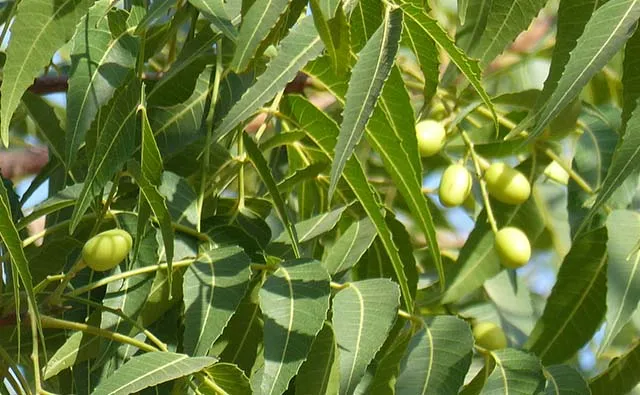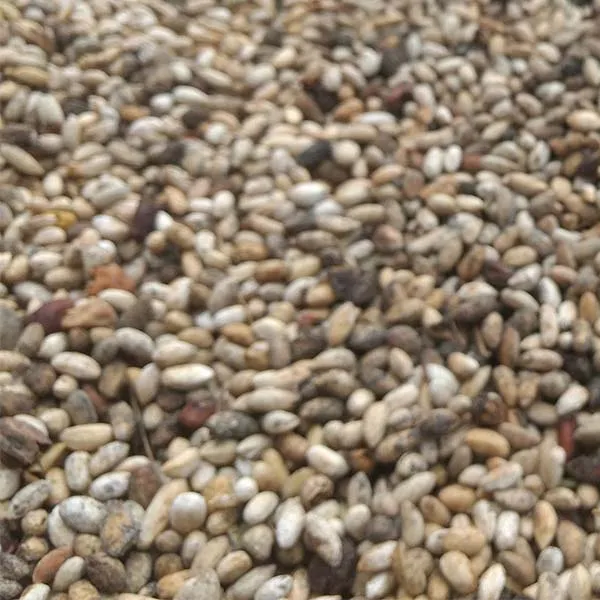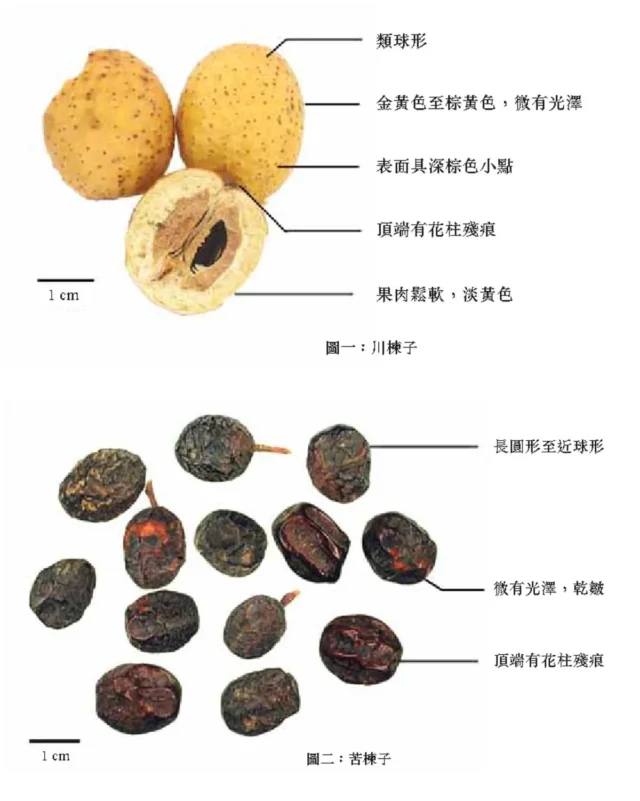Feature Article, Company News
Indian Neem Tree & Chinese Chinaberry Tree and Their Agricultural Applications

Feature Article, Company News

Cover pic belong Dinesh Valke, Flickr
The Indian Neem Tree (Azadirachta indica), also known as Indian lilac, is highly esteemed in India for its medicinal and agricultural benefits. In traditional Ayurvedic medicine, Neem is celebrated for its antibacterial properties and its positive effects on skincare, dental health, and digestive health[1,2]. Since the 1960s, Neem leaves and seeds have been used in agriculture to combat pest infestations, particularly desert locusts (Schistocerca gregaria)[3].

Azadirachta indica seeds © Wikipedia
In the 1970s, researchers J.H. Butterworth and E.D. Morgan from Keele University identified Azadirachtin (AZA)[4], a limonoid compound prevalent in Neem seeds. Azadirachtin is a highly oxidized tetranortriterpene compound, characterized by its complex molecular structure, including secondary and tertiary hydroxyl groups, a tetrahydrofuran ether, and 16 stereoisomeric centers. In 2007, Steven Ley’s team at Cambridge University achieved a small-scale total synthesis of Azadirachtin using a ‘relay method’[5]. Consequently, modern plant protection products containing Azadirachtin are primarily derived from Neem seed extraction, with these products often receiving organic certification from organizations like OMRI.
Through years of research and commercial operations, both by Indian folk traditions and official institutions, India has established industry organizations such as The Neem Foundation, aiming to promote this plant resource to the global market. Currently, Azadirachtin products are quite popular in the European and American markets as a green alternative to traditional agricultural insecticides. Unlike the commercialized scale of the Indian Neem Tree, the Chinese Chinaberry, also known as Bead Tree, with the scientific name Melia azedarach, has not reached the same level. Botanically, the Chinese Chinaberry and the Indian Neem Tree both belong to the Meliaceae family, but they are different genera.

The fruits of Melia toosendan Sieb. et Zucc (Top), called “Chuan Lian Zi” and the seeds of Melia azedarach L., called “Ku Lian Zi”. © Chinese Medicine Regulatory Office (CMRO), Department of Health, Hong Kong
In traditional Chinese medicine, doctors use the fruit of the Chinaberry tree, known as ‘Ku Lian Zi,’ for medicinal purposes. ‘Ku Lian Zi (苦楝子)’ is divided into ‘Chuan Lian Zi (川楝子)’ and ‘Ku Lian Zi.’ ‘Chuan Lian Zi’ refers to the fruit of the Chuan Lian tree (Melia toosendan Sieb. et Zucc), while ‘Ku Lian Zi’ is the fruit of the Chinaberry tree (Melia azedarach L.). According to traditional Chinese medicine records, both fruits have effects such as expelling roundworms, treating abdominal pain, and treating tinea capitis[6]. In the 1950s, Chinese scientists isolated Toosendanin (TSN), which, like Azadirachtin, is also a triterpenoid compound. Research on Toosendanin primarily focuses on medicine, particularly its inducing and blocking mechanisms. In plant protection, the emphasis is mainly on Chinaberry oil extracted from leaves or bark. Similar to the insecticidal properties of the Neem tree, Chinaberry extract effectively controls grasshoppers and locusts.
According to FAO records, Azadirachtin is a versatile insect growth regulator. It mainly works by deterring feeding and hindering insect egg development. It is efficient in managing over 200 insect species from various orders like grasshoppers, bugs, aphids, thrips, wasps, beetles, moths, and flies. Additionally, it can directly harm soft-bodied pests such as aphids and mites on contact. For optimal results when using Azadirachtin emulsifiable concentrate products, it is advisable to administer it as a spray on leaves or soil when pests or eggs are first noticed, followed by weekly applications[7].
The pest control ability of Azadirachtin, according to related studies, is derived from over 300 phytochemicals found in different parts of the Indian Neem tree. Among these, more than 130 compounds belong to the limonoid-type triterpenes[8]. Limonoids are the bitter components responsible for the taste of citrus fruits, and Azadirachtin is a typical example of this class of triterpenes used as an antifeedant, considered the main active component of limonoids[9]. Additionally, Azadirachtin has remarkable selectivity[10], with an LD50 toxicity of only 5000 mg/kg in mammals[11], making it one of the best alternatives to traditional insecticides in Integrated Pest Management (IPM) programs.
The antifeedant effects of Azadirachtin are crucial, impacting insects from various orders like Orthoptera, Lepidoptera, Hemiptera, Coleoptera, and Diptera[12]. Among these, desert locusts (Orthoptera) are the most sensitive to Azadirachtin, displaying antifeedant behavior even at concentrations as low as 0.01 ppm. Lepidoptera also exhibit high sensitivity, showing noticeable antifeedant behavior at concentrations of 50 ppm. Coleoptera, Hemiptera, and Homoptera are slightly less sensitive but can still achieve a 100% antifeedant rate within a concentration range of 100 to 600 ppm[13].
Primary antifeedant behavior in insects involves using their sense of smell to find food, followed by taste reception upon contact. Studies indicate that Azadirachtin’s primary antifeedant impact might be influenced by taste chemoreceptors[12]. Azadirachtin triggers particular ‘deterrent’ cells in the chemoreceptors, inhibiting the activation of ‘sugar’ receptor cells responsible for promoting feeding[13].
Azadirachtin also affects the endocrine system of target pests by disrupting hormone secretion, including ecdysteroids and gonadotropins. It negatively impacts egg production and vitellogenin synthesis. Application to oviposition sites interferes with sex pheromones, repelling pests from laying eggs[13].
In contrast, Toosendanin from the Chinese Chuanlian Tree is typically extracted from the bark. Studies show that Toosendanin has significant effects on Phthiraptera insects, exhibiting gastric toxicity at 252.23 ppm[14]. Azadirachtin, however, is effective against Diptera, such as Aedes aegypti larvae, with efficacy observed at 60.8 ppm[15].
An interesting note is that in Chinese, both the Indian Neem Tree and the Chinese Chinaberry Tree are referred to as “苦楝树” (Ku Lian Shu). This nomenclatural ambiguity often leads to the misconception that they are closely related. Botanically, while both belong to the Meliaceae family, their similarities are limited to this family. Chemically, Azadirachtin (C₃₅H₄₄O₁₆) is more complex than Toosendanin (C₃₀H₃₈O₁₁). Both are triterpenoids, but Azadirachtin features multiple six-membered rings and oxygen bridge structures, with its activity derived from cyclic diterpene groups and various functional groups. Toosendanin has an epoxytriterpenoid core structure, with its main activity stemming from its epoxy bridge and acetyl ester groups.
From a toxicological perspective, Azadirachtin is very low in toxicity to mammals, whereas Toosendanin has mammalian toxicity, with an LD50 of 13.84 ppm for intraperitoneal injection and 244.2 ppm for oral ingestion[16]. Thus, Azadirachtin is more suitable for plant protection formulations, while Toosendanin is often used as an antagonist with therapeutic effects against botulism[17].
According to FAO guidelines, Azadirachtin has a solubility of approximately 2.9 g/L in water and is most stable in weakly acidic solutions with a pH between 4 and 6. Its photolytic characteristics indicate that its tigloyl moiety may undergo photooxidation under certain conditions, leading to hydrolysis or cleavage of ester bonds and the formation of highly strained 3-membered and 5-membered epoxides. This can reduce the effective persistence of Azadirachtin-based formulations. Therefore, Azadirachtin emulsifiable concentrates (ECs) should be used within 8 hours of mixing to maintain efficacy, with storage recommendations of no more than 5 days in summer or 1.8 months in winter.
When combining Azadirachtin ECs and similar products like Neem tree extract ECs, it’s crucial to remember that these products are typically oil-in-water (O/W) emulsions. To create a stable emulsion, add water slowly to the oil phase. Adding water directly to the emulsifiable concentrate, especially without proper stirring, can cause oil-water separation and impact the product’s effectiveness. Adequate and thorough stirring is vital. When mixing with wettable powders, make sure the emulsion is completely prepared before adding the powder.
Additionally, according to the usage recommendations for Fortune® Aza, to maintain optimal biological activity, it is suggested to mix it with oil-based adjuvants. When using terpene-based bio-oil adjuvants like PINEYE® EC, which contains mainly Poly-1-p-Menthene monoterpene, it is well-suited for mixing because Azadirachtin, a triterpene compound, has a complex and stable chemical structure. The concentrate of PINEYE® EC is chemically compatible with Azadirachtin and does not diminish its effectiveness or lead to negative reactions.

Pineye® EC, a bio-based adjuvant. It is a golden viscous liquid before being prepared into emulsion.
PINEYE® EC is commonly used as an anti-transpirant, sticker, and extender adjuvant. The emulsion has natural adhesive properties and whenmixed with Azadirachtin products, it helps increase the spray coverage on plant surfaces. The deposition rate is 6.6623 mg/cm². Once applied, PINEYE® EC dries within an hour, forming a flexible film that encases the liquid in microcapsules. With a contact angle of 44.50°, it also aids in dispersing Azadirachtin, promoting better adhesion to the plant surface at a reduced contact angle.

Contact Angle and Externded Area Test Data of Pineye® EC.jpg
Fortune® Aza suggests using “raincoat-type” products when facing rainy weather. PINEYE® EC, known for its ability to retain moisture and reduce evaporation in sunny conditions, can also help prevent the loss of Azadirachtin when it rains.
However, more application reports are needed to determine if PINEYE® EC can effectively mix with water-soluble azadirachtin products. Apart from the EC-type azadirachtin products (or neem extract products) available in the market, there are also wettable powder products like Arborjet® AzaSol. PINEYE® emulsion is primarily utilized as an adhesive or film-forming agent, creating a thin film on plant surfaces to extend the effectiveness of pesticides or active substances. Yet, if the emulsifier or surfactant is not used correctly, PINEYE® EC might struggle to create a stable mixture with azadirachtin in water. The film-forming properties of PINEYE® EC should not overly hinder the effectiveness of AzaSol. It is crucial to allow Azadirachtin to penetrate the plant surface and maintain its efficacy.
Therefore, further experimentation and collection of customer feedback are needed to determine the compatibility and application of PINEYE® EC with wettable powder formulations of Azadirachtin.